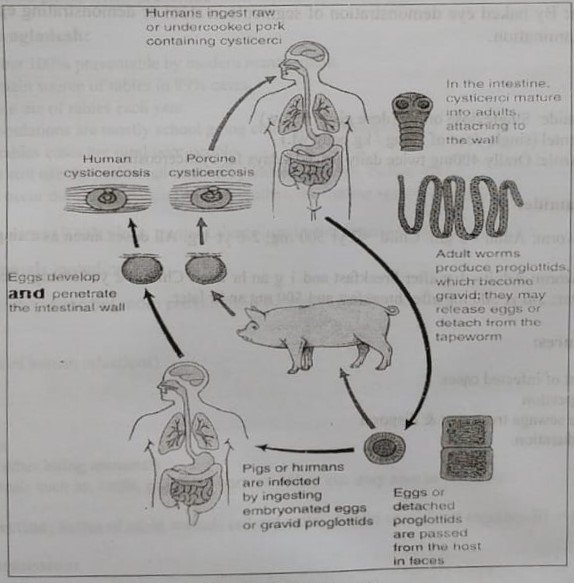Today is our topic of discussion Definition of Taeniasis
Definition of Taeniasis
Definition:
Infections involving the pork (T. solium) and beef (T. saginata) tapeworms are called taeniasis.
Distribution:
Taenia saginata has high endemicity in Latin America, Africa and Middle East. Taenia solium is prevalent in Latin America, Africa, Southeast Asia, India, and China. Overall infection rate is dependent on dietary habits

Fig: Tape worm
Epidemiological determinants:
Agent:
a) Taenia saginata: Adults are tape like; segmented; may force anal sphincter; show activity outside.
b) Taenia solium: Adults are tape like; passed passively; no activity outside.
Host: Two hosts –
a) Definitive host: Man
b) Intermediate host: Cattle in T. saginata & pig (sometimes man) in T. solium [muscle and other tissues]
Route of entry:
Orally by eating undercooked beef /pork infected with larvae.
Mode of transmission:
a) Eating raw or undercooked meat (containing larval form of the tapeworm cysts)
b) Eggs ingested through food, water or soil contaminated with human or animal (host) faeces
c) Reinfection by transport of eggs from intestine to stomach by retro-peristalsis is rare.
Incubation period:
8-14 weeks

Fig: Life cycle of Taenia solium
Cysticercosis:
Eggs ingested via food contaminated with faeces. Ingested eggs develop into larvae, which migrate out of the intestines and form cysts in other tissues such as the lungs, liver or brain (causes severe headache & seizure). This type of infection is not common with beef but can occur with the pork tapeworm. This is called cysticercosis.
Life cycle:
Eating under cooked beef /pork infected with larvae Pass to intestine Larvae become free by action of digestion Within 2-3 months becomes an adult worm → The gravid segments discharged & come out of anus Passes to grazing fields where it remains viable for many months Intermediate host becomes infected by eating eggs with grasses.
Eggs passes to intestine → With the help of hooks passes through intestinal wall→ Carried by blood to
muscles (tongue, neck, shoulder, arm and cardiac muscle) Develops into infective larva (Cysticercus bovis
in cattle or Cysticercus cellulosae in pig and occasionally in man) → Cysticercus survive for several months→→
If not taken up by definitive host to repeat the cycle →→ Calcified.
Clinical feature:
May remain asymptomatic. Usual features are –
1. Occasionally vague abdominal pain with abdominal disturbances
2. Diarrhoea
3. Loss of appetite
4. Migrating segments may cause appendicitis, intestinal obstruction and cholangitis.
Lab. diagnosis:
By naked eye demonstration of segments in stool or demonstrating eggs in stool by microscopic examination.
Treatment:
1. Niclosamide: Single dose orally (dose given below)
2. Praziquantel (single dose of 10mg/kg body wt.)
3. Albendazole: Orally 400mg twice daily for 7-14 days for cysticercosis.
Dose of niclosamide:
1. Pork tapeworm: Adult – 2 gm. Child: yr 500 mg; 2-6 yr 1 g. All doses taken as a single dose after a light breakfast.
2. Beef tapeworm: Adult – 1 g after breakfast and 1 g an hr later. Child: <2 yr 250 mg after breakfast and 250 mg an hr later; 2-6 yr 500 mg after breakfast and 500 mg an hr later.

Control measures:
a) Treatment of infected cases b) Meat inspection
c) Adequate sewage treatment & disposal d) Health education.
See also :
